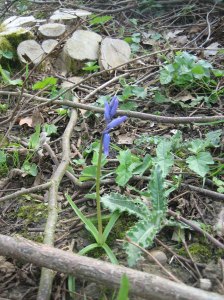Ah the bluebell – that beauty of our ancient woodlands, that brilliant woodland welcomer of spring. They are flowering right now in our tiny bit of ancient woodland and they look gorgeous in the fragile April sunshine. So welcome in a sea of vivid green, after months of grey and damp.
As we all know, the bluebell is “an indicator of ancient woodland”. Well actually those of us who have a history of woodland stuff and tree obsession know this, everyone else is able simply to enjoy them. As an indicator, they are meant to appear in woodland very slowly and remain for centuries, lacking any ambition to colonise, just rolling with the tide of the seasons and celebrating the occasional flood of light brought about by coppicing. Along with certain other species, dogs mercury being one such, their presence in a wood (at least in lowland UK woodland) suggests a wood that has been in existence for centuries.
We planted a wood in 1999, next to our sliver of old woodland. Two years ago, bluebells appeared in the wood across a ride, some 8 metres from the old wood. This year one has appeared in a coppice plot I cut last winter. Now I admit the first ones may have been the result of my sprinkling pocketed seed. This one however, wasn’t, at least as far as I can recall. It’s only small and it looks pretty vulnerable, but does it suggest that my certainty that bluebells travel very slowly might be misplaced? Any thoughts bluebell people?

